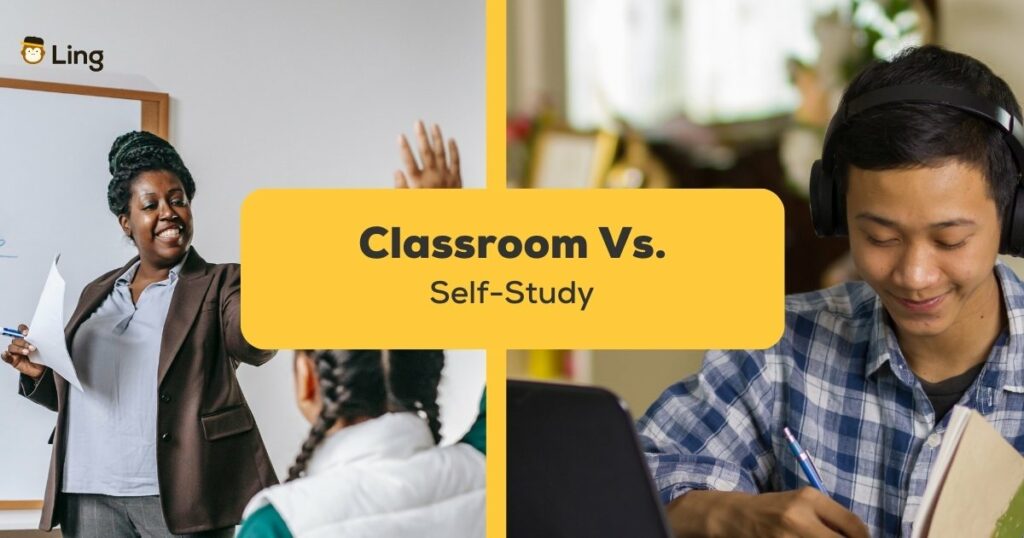Learning a new language can be a wonderful experience, opening new opportunities for personal and professional growth. With the expansion of technology and the advent of language learning platforms, the age-old debate about learning a language in the classroom vs. self-study has become even more heated.
We will explore the pros and cons of learning a language in a traditional classroom versus learning on your own using a thousand resources, including social media, apps, YouTube, or ChatGPT. We hope that at the end of this post, you can find the most suitable choice for yourself.
Classroom Vs. Self-Study
1. The Classroom Experience
Advantages:
Some individuals may lack the self-discipline at the beginning of their journey to learning a new language. Thus, when they go to classes, they get a teacher that gives them what to study, how, when, what is wrong and what not, and homework, so they can practice at home even when unmotivated.
Signing up for a class is better if you know nothing about your target languages. We have seen many people trying to learn a new language from scratch independently, often ignoring or missing some fundamentals like grammar, pronunciation, or language-specific logic specific to each language.
Let’s take Chinese as an example; it’s hard for you if you learn this language on your own without initial instruction in the alphabet and pronunciation. Because it’s obviously a complicated language.
Learning a language in a traditional classroom has several advantages:
● A structured curriculum serves as a roadmap for systematic progression, fostering an understanding of language development
● Providing guidance, support, and instant feedback enhances learning efficacy.
● Interacting with classmates offers invaluable speaking practice and opportunities for group activities.
● Engaging in real-world conversations facilitates authentic language interactions, making learning enjoyable and stimulating.
P/s: If you want to take a language class, the best advice is to pick up an online course where you can practice maximum and get feedback directly from your tutor.
Disadvantages:
There are potential drawbacks to consider.
● Traditional classroom settings can be expensive, and the curriculum may not always cater to individual learning needs.
● A classroom environment’s rigid schedule and pace might also be unsuitable for those with demanding work or personal commitments.
● You would have to study lessons you are not as interested in learning.
● Other learners might slow you down.
In fact, some people prefer to avoid language classes because they feel they are too slow. The fact that 5 years of studying English at school has helped many people reach the level from A1 to A2. For the same amount of time, 5 months of self-study has brought you to B2. The difference is HUGE.

The Self-Study Journey
Self-study might suit you best if you are a language lover, self-motivated, and enjoy exploring independently. This approach has ups and downs; each can be beneficial or challenging, depending on your mindset.
People who prefer self-study often appreciate the following:
● Setting their own study pace
● Choosing their own materials
● Focusing on topics they are interested in
● Having no fixed schedule or mandatory classes
● Saving money by not hiring a tutor
● And enjoying tracking their own progress.
While self-studying a language can offer many benefits, it also has some potential downsides:
● Lack of structure: Without a definite curriculum or lesson plan, knowing where to start or what to focus on can be difficult.
● Limited Feedback: Without a teacher or classmate, it can be difficult to get immediate feedback on pronunciation, grammar, or usage.
● Motivation challenges: Some people may have difficulty staying motivated when studying alone because of the absence of external pressure from teachers or peers.
● Lack of opportunity for practice: While self-study can help with reading and writing skills, it may not provide many opportunities to practice listening or speaking, especially in interactive situations.
● Difficulty with complex concepts: Some aspects of language learning, such as complex grammar rules or nuances in pronunciation, can be challenging to understand without a teacher.
Ready For Language Learning?
We can see the benefit of classes when you are a beginner with the language, but after a certain point, you can only learn so much from a course. After a while, how much you improve would be up to you. And, of course, combining classes and self-study is the best alternative!
Ling provides an excellent alternative for those seeking a flexible, personalized learning experience complemented by available support and community resources. By carefully evaluating the pros and cons of each approach, you can embark on a successful language learning journey.
Remember, the most vital aspect of learning a language is to practice and seek feedback regularly, regardless of the chosen approach. Whichever method you select, embracing the joy of learning will make the process all the more rewarding.
Download the Ling app from Google Play or App Store today!
By: Minh Cuong from Romanlangpassion.com



































































